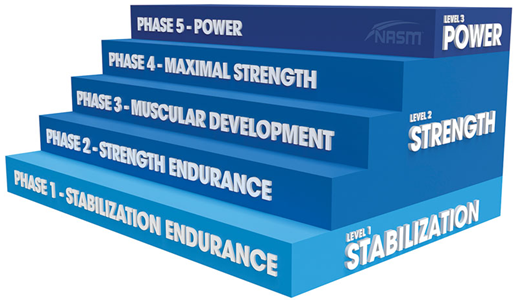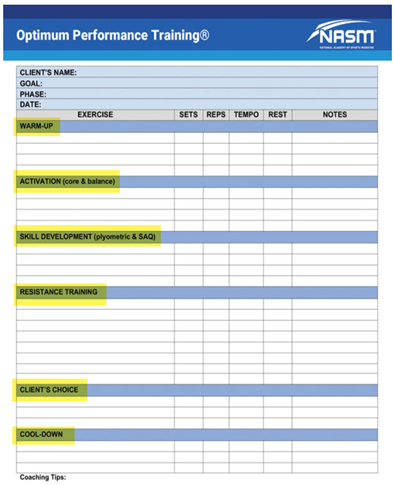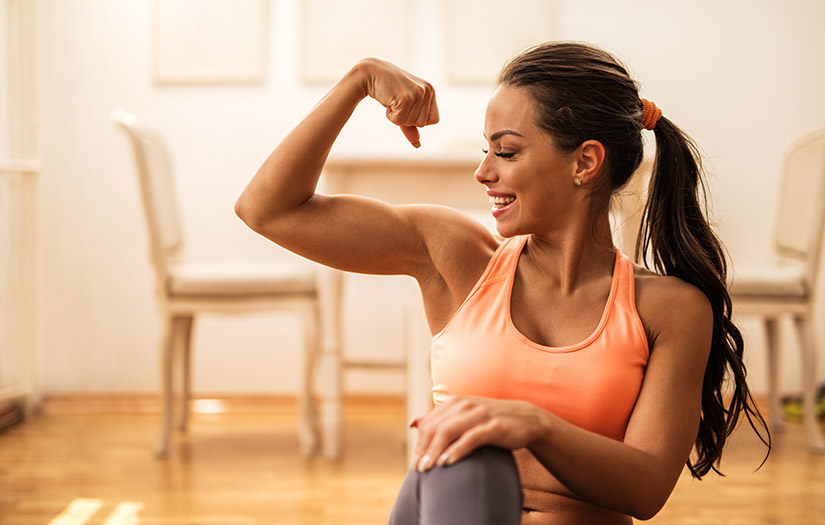BY NASM
Moving along in our discussion of the different phases of the Optimum Performance Training (OPT) model, next, we have Phase 3 Muscular Development Training. Phase 3 is the second phase of the Strength Level of the OPT model. As a quick reminder, the OPT model is split into three different levels and a total of five training phases. It is a fundamental part of the CPT course. You can find the figure of this below.
Still, the three levels consist of stabilization, strength, and power, and the five phases of training consist of Stabilization Endurance, Strength Endurance, Muscular Development, Maximal Strength, and Power. For this discussion, we are going to go over muscular development.
But what is muscular development? Otherwise known as hypertrophy (the enlargement of tissue), muscular development training focuses on the adaptation of maximal muscle growth with an overall emphasis placed on higher levels of training volume. As always, we will discuss the specifics of the different training variables later on.
Before jumping straight into Phase 3, below, you can find a visual representation of the entire OPT model.

In my experience (and I am sure many of you can agree with me), this training style is what I see most often when I walk into most gyms. Despite how common it may be, it is essential to understand all of its nuances. Muscular hypertrophy may not be advantageous for everyone.
For example, an endurance athlete may not benefit from muscular development in the same way as a bodybuilder or physique athlete. Unlike the other phases, however, Phase 3 can achieve a wide range of goals such as increasing lean mass, reducing body, improving strength, and muscular endurance. These adaptations are accomplished by altering the different acute variables based on the desired adaptation.
For example, we can decrease rest period intervals while maintaining a relatively higher repetition count, which is ideal for muscular endurance and cardiorespiratory conditioning.
When following the OPT model, Phase 3 sits right in the middle. Typically, individuals will stay in this phase for about two to six weeks (like the other phases). From there, individuals will either cycle back through Phases 1 and 2 or make the transition to Phases 4 and 5. This cycling is usually based on the recommendations of a fitness professional. Undulating periodization is also an option in which Phase 3 is integrated into a weekly or monthly plan with other phases of the OPT model.
DESIGNING A PHASE 3 WORKOUT
When designing a Phase 3 program, we will consider the same training components we covered in the previous two phases (and the same ones we will cover in the following two as well). These components include:

• Warm-Up
• Activation
• Skill Development
• Resistance Training
• Client’s Choice
• Cool-Down
Each component is designed and implemented to help elicit a specific physical adaptation. However, you might not always have adequate time to use them all within a single workout.
It will be up to the discretion of you, the fitness professional, to pick and choose which components are most important for your client. With that said, let’s look at a quick breakdown of each and see how they work within Phase 3 of the OPT model. Because the second level of the OPT model contains three separate phases, we may begin to see some overlap on some of the training principles, so bear with me if any of this sounds familiar.
WARM-UP
Recall, during a Phase 1 program, the warm-up consists of self-myofascial techniques (e.g., foam rolling), static stretching, and optional light cardio and/or dynamic stretching. Phases 2-4 involve a similar approach; however, they integrate active stretching instead of static stretching.
We’ll go over some of the specifics in a bit, but first, I think it is important to have a solid understanding of active stretching. This variation of stretching uses both agonist and synergist muscles to achieve the desired ROM and helps increase the motor neuron excitability, which helps create reciprocal inhibition of the muscle being stretched (Kenny et al., 2019; Vernetta-Santana et al., 2015).
We did not cover it in the last blog post, but for those that may need a little refresher, reciprocal inhibition is when an antagonist muscle receives an inhibitory single to relax and lengthen, which allows the agonist to shorten/contract. Each active stretch consists of 5-10 repetitions, and each repetition is held for one to two seconds.
Finally, we have our two optional components, dynamic stretching and cardio. Dynamic stretching aims to take a joint(s) through a full range of motion to increase joint mobility and range of motion further. Often, these movement patterns begin to reflect the movements that will be required of our clients during their workout (e.g., push-ups, bodyweight squats, lunges with rotation).
Cardio is our second optional component if time allows. Cardio exercise should last between 5 to 10 minutes and is used to literally “warm-up.” The goal of pre-exercise cardio is to increase an individual’s heart rate, respiration rate, tissue temperature, and help prepare the client for higher exercise intensities (McGowan et al., 2015; Silva et al., 2018). The table below provides a synopsis of a Phase 3 warm-up protocol.
Phase 3 Muscular Development Training Warm-up
| Techniques | Acute Variables |
| 1. Self-Myofascial Techniques | 1-3 muscle groups, 1-3 sets, 30 seconds per muscle |
| 2. Active Stretching | 1-3 muscle groups, 1-3 sets, 5-10 repetitions, hold each stretch 1-2 seconds |
| 3. Cardio (Optional) | 5-10 minutes, light intensity |
| 4. Dynamic Stretching (Optional) | 3-10 exercises, 1 set, 10-15 repetitions |
Below is an example of SMT and an active stretch for the hamstring complex. A similar strategy of inhibiting and lengthening the same muscle groups during a warm-up provides the best response for increasing range of motion and joint mobility. It should be used for all muscle groups the fitness professional deemed overactive during the assessment process (i.e., Overhead Squat assessment).


ACTIVATION
The best way to look at the activation phase of our workout is to think of it as a continuation of our warm-up. This concept was already touched on heavily in a previous post to spend too much time on it here. During the warm-up, we focused our attention on ensuring we addressed any overactive muscles (using SMT and stretching techniques).
For the activation portion of the program, we are addressing underactive muscles. Targeting underactive muscles is done primarily with core and balance-based exercises, which we will cover in more detail below. Remember, all of this information about muscle imbalances is gained through a comprehensive pre-exercise assessment process.
The main goal of activation in the strength level of the OPT model (remember strength level of the OPT model includes Phases 2-4) is to see a progression from the stabilization level. This progression is accomplished by having exercises/movements that involve more dynamic eccentric and concentric motion.
For example, during core training, the exercises progress to include motion of the spine such as spinal flexion, extension, and rotation. Common core exercises that follow this protocol include crunches, reverse crunches, and cable rotations. This contrasts with the exercises used in Phase 1 that emphasize isometric contractions of the core (slight spine motion) such as planks, bridges, bird dog, and Pallof press.
In addition, balance exercises involve more motion of the balance leg compared to Phase 1. During Phase 1, balance exercises focus primarily on static balance and include exercises that involve slight movement of the stance leg (e.g., single-leg balance, single-leg balance reach). However, in the strength level of the OPT model (Phases 2-4), balance exercises are progressed to include eccentric and concentric motions of the balance leg. Examples include a single-leg squat, step-up to balance, and lunge to balance.
The different sets and repetitions will remain the same across the entire strength level in terms of programming. It is recommended that individuals complete one to four exercises with a repetition range of 8-12. In total, each exercise can be completed for a total of two to four sets.
SKILL DEVELOPMENT
Our two main skill development components are plyometric and speed, agility, and quickness (SAQ) drills. This portion of the workout is optional and may not be completed, whether this has to do with time restraints or the client’s type and goals.
Plyometric and SAQ exercises can be very effective training styles, but they may not be for everyone. Always ensure the training format and exercises are appropriate for your client and modify as necessary. If this style of training is not the best option for your client, you can use this time to begin to introduce other new skills, such as learning the basics of using new equipment (i.e., kettlebells, battle ropes), Olympic lifting (with a bar or dowel rod), or martial art drills. It is essential to realize that this portion should only consist of instruction and learning, not high-intensity work.
When programming for skill development in the strength level of the OPT model, exercises are progressed to include movements involving jumps with more amplitude and dynamic motion for plyometrics than exercises used in Phase 1 that involve low amplitude. Jumps can also become more repetitive (assuming it is appropriate for your client), unlike in Phase 1, where the focus was placed on holding the landing position for 3-5 seconds.
As for SAQ, in Phase 3, drills can become faster movements and involve greater horizontal inertia. As a fitness professional, when it comes to plyometrics, you can select one to four different drills/exercises and have your clients perform between 8-12 repetitions for a total of two to four sets. When programming for SAQ, it is recommended to select one to four drills/exercises and have each one completed for three to five repetitions and a total of two to four sets.
RESISTANCE TRAINING
As we already mentioned, Phase 3 of the OPT Model is specific to muscular development, otherwise known as muscular hypertrophy. Despite muscle growth as the primary goal, Phase 3 can also help with other common fitness goals, such as altering body composition (i.e., fat loss). It is important to note that preserving muscle mass is vital when undergoing a fat loss program (Cava et al., 2017).
Consequently, Phase 3 can be a powerful form of exercise for those seeking to shed excess pounds. Proper progression through Phase 3 requires systematically increasing volume and intensity. In most cases, the fitness professional should choose two to four exercises (per body part) and have their clients complete a total of 6-12 repetitions for three to six sets.
We can even see this volume increase further; repetition ranges between 12-20 can also be used within Phase 3 if clients seek further improvements in muscular endurance (Schoenfield et al., 2015, 2019).
CLIENT’S CHOICE
Like in our previous phases, this workout section allows your client to choose one or two of their favorite exercises. At this point, any exercise is permitted as long as you, the fitness professional, deem it safe and effective.
COOL-DOWN
The cool-down is identical across the entire OPT Model and should last somewhere between 5-10 minutes. It is very similar to the warm-up and consists of an optional cardiorespiratory component, SMT, and static stretching. It was mentioned in the Phase 1 article, but it is worth saying again, the cool-down is a critical component of the workout.
As a fitness professional, make sure you set aside enough time to allow your client(s) to cool down properly at the end of each workout. Plus, you can also use this time to discuss the training session and any future plans.
ACUTE VARIABLES
Other than specific training principles, acute variables are where we see the differences between the OPT model’s different phases. Phase 1 kept us on the lower end of volume and intensity, focusing on high repetitions, low sets, and low weight (relative to the individual). I mentioned this in the first blog, but I like to look at the acute variables as a spectrum.
If Phase 1 is on the far left (i.e., low volume, light loads), where does that put Phase 3? Right in the middle, which means, since it is a spectrum, it takes on the characteristic of both sides. Phase 3 has the best of all worlds, a wide range for both sets and repetitions, and increased training intensity.
Below, you can find a breakdown of all of the acute variables for Phase 3 Muscular Development Training.

CONCLUSION
Phase 3 is ideal for those seeking improvements in muscular hypertrophy and a reduction in fat mass. However, clients must be functionally ready for this type of training. Phases 1 and 2 of the OPT model help develop the necessary components to partake in muscular development training safely and effectively.
Once a client has displayed adequate movement quality, muscular endurance, and joint mobility and stability, they can safely perform a Phase 3 workout. I hope this quick breakdown of muscular development training gave you a solid understanding of what a workout should look like and how to structure a proper program.
This article only scratched the surface of the content and information of Phase 3 training, so make sure to review NASM’s CPT 7th edition program for more details. Phase 4 will come next, where we shift into discussing maximal strength.

